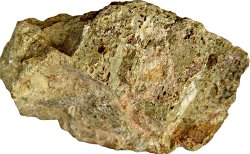
 | How Rare Earth minerals form |
Rare Earth Elements (REEs) are metallic elements which are increasingly in demand because of their use in modern technologies. The elements might be 'rare' but they turn up in a number of everyday items - for example electronic products such as smartphones, batteries, electric cars, green energy technologies and so on. In fact the modern world is completely dependent on REEs. For example, a fully electric car contains approximately 30 kg of REEs. They are found in the glass, electronics, batteries and catalytic converters. A 1.5 MW wind turbine requires approximately 350 kg of REEs - mostly Neodymium (Nd).
In the periodic table REEs are known as the Lanthanide series. They are subdivided into two categories: light REEs with atomic numbers between 57 and 64 and heavy REEs with atomic numbers between 65 and 71. Because of similar chemical properties Yttrium (Y) is also classified as a heavy REE (see tables below). One additional metallic element - Scandium (Sc) is often included as a REE but technically Sc is a light transition metal.
| 57 La Lanthanum | 58 Ce Cerium | 59 Pr Praseodymium | 60 Nd Neodymium |
| 61 Pm Promethium | 62 Sm Samarium | 63 Eu Europium | 64 Gd Dadolinium |
| 65 Tb Terbium | 66 Dy Dysprosium | 67 Ho Holmiun | 68 Er Erbium |
| 69 Tm Thulium | 70 Yb Ytterbium | 71 Lu Lutetium | 39 Y Yttrium |
Although Rare Earth compounds find increasing use in new technologies, there is still much we don't know about these metals. For example, how are they formed? The main source of REEs are carbonates, the most notable being bastnaesite. Bastnaesite is a carbonate-fluoride with a general formula of (REE)CO3(F,OH) since some of the minerals contain OH- instead of F-. The minerals with OH- substitution are known as hydroxyl bastnasite. Bastnaesite is a family of three minerals, the main one being bastnaesite-(Ce) with a formula of (Ce, La)CO3F. Cerium fluoride carbonate is found in contact metamorphic zones and pegmatites (a coarsely crystalline granite or other igneous rock). Contact metamorphism happens when rock is heated up by an intrusion of hot magma.
Cerium is often substituted by lanthanum [(La, Ce)CO3(F,OH)] or yttrium [(Y, Ce)CO3(F,OH)] giving rise to the other two members of the bastnaesite family.
The other notable sources of REEs are phosphates: monazite [(REE)PO4] and xenotime [(Y,REE)PO4]. Monazite is a primarily reddish-brown mineral containing most commonly Ce,La, Nd and Th. Xenotime is a rare-earth phosphate mineral, the major component of which is yttrium orthophosphate (YPO4).
To understand better how the REEs interact with carbonates and form compounds, researchers from Trinity College in Dublin created synthetic REEs by applying REE-rich aqueous solutions to dolomite (CaMg(CO3)2) and aragonite (CaCO3) with the samples at temperatures varying between 25 and 220oC. The REEs used for those experiments were La, Pr, Nd and Dy.
The scientists observed that once the host samples (dolomite or aragonite) were placed in contact with the REE-rich aqueous solution, calcium+2 (Ca+2), magnesium+2 (Mg+2) and carbonate CO3-2 ions were released. As the concentration of the CO3-2 ions increased at the border between the solid and liquid phase, dissolved REE+3 ions were precipitated from the solution as REE-carbonate polymorphs on the surface of host rock in a temperature-dependent manner.
At low temperatures of less than 80oC, La, Pr, and Nd crystalised first into Lanthanite minerals (this mineral group has a general formula of (REE)2(CO3)3·8(H2O)) with secondary crystallization into Kozoite [orthorhombic REECO3(OH)]. At high temperatures (165-220oC) these three elements underwent final differentiation into hydroxyl bastnasite [hexagonal REECO3(OH)]. Similar results were obtained with both aragonite and dolomite.
The crystallization process of Dysprosium (Dy), the only heavy REE used in this experiment, was different from those of La, Pr, and Nd. The interaction of Dy-bearing solution with dolomite resulted only in crystallization of kozoite [orthorhombic DyCO3(OH)] and this required temperatures of 80oC or higher. Interestingly when Dy-bearing solution was applied to aragonite the researchers observed a two-step crystallization pathway: tengerite [Dy2(CO3)3·2-3(H2O)] to kozoite [orthorhombic DyCO3(OH)].
Under laboratory conditions Dy never crystallized into bastnasite.
Dy3+ ions are smaller than the other REEs used in these experiments and the researchers believe that they are too small to create stable bonds which progress to bastnasite crystals. Indeed this is exactly what seems to happen in nature. Bastnasite normally contains larger REE irons (from La3+ to Nd3+) , while Dy3+ and other smaller (heavier atomic weight) REEs are found only as impurities in a low concentration.
"The genesis of rare earth deposits is one of the most complex problems in Earth sciences, but our approach is shedding new light on the mechanisms by which rocks containing rare earths form. This knowledge is critical for the energy transition, as rare earths are key manufacturing ingredients in the renewable energy economy." said Dr Juan Diego Rodriguez-Blanco, Associate Professor in Nano-mineralogy at Trinity College and the principal investigator of the work.
Journal Reference:
| _______________________________ | ||||
| Home | | | Shopping | | | Database |
© Biscuit Software 2004-2019
All rights reserved